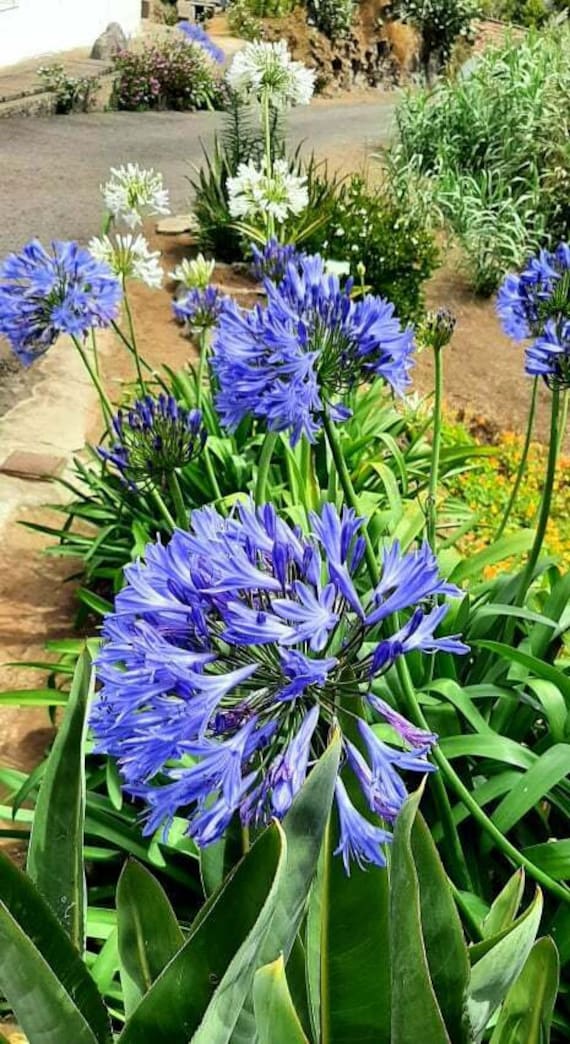Agapanthus Breeding: Tips for Expanding Your Plant Collection
Agapanthus Breeding: Tips for Expanding Your Plant Collection
Blog Article
Letting Loose the Secret to Successful Agapanthus Farming: Tips and Tricks for a Flourishing Yard
In the realm of horticulture, growing agapanthus successfully needs a critical strategy that encompasses different aspects of plant care. By comprehending the subtleties of agapanthus growing, one can produce a setting where these plants grow and flower generously.
Planting Agapanthus: Ideal Practices
When growing Agapanthus, appropriate dirt preparation is essential for making certain successful development and advancement of these attractive blossoms. Agapanthus, generally referred to as Lily of the Nile or African lily, flourishes in well-draining soil with a somewhat acidic to neutral pH level - Agapanthus. Prior to growing, it is crucial to amend hefty clay soils with natural issue such as compost or peat moss to boost drain and give necessary nutrients for the plants
To plant Agapanthus, select a place that obtains full sunshine to partial shade, as this will certainly promote healthy and balanced growth and bountiful flowering. Dig a hole two times the diameter of the plant's origin sphere and position the Agapanthus at the same deepness it was formerly growing. Carefully backfill the hole with soil, pushing down securely to get rid of any air pockets around the origins.
Water the freshly planted Agapanthus extensively and proceed to maintain the dirt equally moist, specifically throughout the plant's active growing period. Agapanthus. Applying a well balanced plant food once a month can additionally sustain the plant's growth and blooming. By complying with these ideal practices for growing Agapanthus, you can develop a spectacular screen of these exciting blossoms in your garden
Suitable Soil Issues for Agapanthus
For optimum development and growing success of Agapanthus plants, making certain the dirt problems are optimal is crucial. Agapanthus favors dirt that is abundant in nutrients, so integrating a balanced fertilizer during the growing period can promote healthy and balanced growth and vivid blossoms.

Watering and Fertilizing Tips
To ensure healthy growth and vivid flowers, proper watering and fertilizing techniques are important for effective Agapanthus farming. Agapanthus plants profit from normal watering, especially throughout the expanding season.
When it concerns feeding Agapanthus, a balanced plant food with equal parts nitrogen, phosphorus, and potassium can be applied in the spring to advertise healthy and balanced growth and blooming. Slow-release plant foods are optimal for offering nutrients progressively over an extensive period. Avoid over-fertilizing, as this can lead to too much foliage development at the cost of blooms.
Additionally, including organic issue like compost into the soil can enhance nutrient degrees and boost dirt structure, assisting in the general health and wellness of the Agapanthus plants. By following these watering and feeding tips, gardeners can ensure their Agapanthus plants grow and create spectacular displays of flowers.
Pruning and Deadheading Strategies
Appropriate pruning and deadheading techniques play a critical role in maintaining the health and wellness and aesthetic appeals of Agapanthus plants, complementing the necessary practices of watering and feeding for successful cultivation. Pruning Agapanthus involves removing invested flower heads, yellowing or dead fallen leaves, and total shaping of the plant to promote better development. Deadheading, the process of removing faded blossoms, not only improves the plant's look yet additionally motivates further blooming.
When deadheading Agapanthus, it is advisable to snip off the blossom stem at the base using sharp, tidy shears. This process reroutes the plant's energy from seed production back right into root and vegetation development, advertising a much healthier and much more robust plant. Normal deadheading can extend the flowering duration of browse around here Agapanthus and prevent self-seeding, which can cause congestion.
In regards to trimming, Agapanthus generally gain from a light trim after flowering to clean up the plant and urge fresh growth. Cutting down the invested blossom stems and removing any damaged or dead foliage helps maintain the plant's vitality and total appearance. However, it is important to avoid cutting right into the crown of the plant, as this can weaken its health and wellness.

Protecting Agapanthus From Pests and Diseases
Carrying out reliable pest and illness monitoring techniques is vital to safeguarding the wellness and vigor of Agapanthus plants in growing. One usual insect that influences Agapanthus is the Agapanthus borer, a caterpillar that passages into the plant, causing damages to the blossoms and fallen leaves.
In addition to parasites, Agapanthus are susceptible to conditions such as origin rot and fungal fallen leave spots. These problems can frequently be avoided by making sure correct drainage and staying clear of overwatering. If signs of illness show up, impacted components of the plant must be immediately removed to protect this content against more spread. Fungicides might additionally be used as a therapy step, complying with the producer's directions carefully. By remaining vigilant and addressing parasite and condition problems quickly, gardeners can aid their Agapanthus thrive and grow.

Verdict
In verdict, effective growing of agapanthus requires proper planting techniques, excellent dirt problems, appropriate watering and feeding, check here routine trimming and deadheading, and defense from bugs and conditions. By complying with these techniques and suggestions, garden enthusiasts can make sure a flourishing yard loaded with beautiful agapanthus blooms. Agapanthus. Bear in mind to maintain regular care and attention to detail to promote the health and wellness and durability of these spectacular plants
When planting Agapanthus, appropriate dirt prep work is necessary for guaranteeing effective growth and advancement of these lovely blossoms.Water the freshly grown Agapanthus extensively and continue to keep the dirt evenly damp, specifically during the plant's energetic growing season.For ideal growth and growing success of Agapanthus plants, guaranteeing the soil problems are ideal is vital. When planting or transplanting Agapanthus, make certain the dirt is well-prepared to provide the needed foundation for the plants to establish themselves successfully. One usual insect that influences Agapanthus is the Agapanthus borer, a caterpillar that tunnels right into the plant, creating damages to the leaves and blossoms.
Report this page